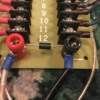Actually, there's no simple test for an open TVS. Unless they're pushed past their triggering limit, they should always appear as an open circuit.
To test a 36V transient diode, you need a power supply that at least can go up to 40V and with a current limiting feature. First set current limit to 20-25mA. Connect TVS leads to positive and negative terminals. With a bipolar TVS, polarity isn't an issue, with a unipolar TVS, you need to observe the polarity. For AC, we're using a bipolar model.
Slowly increase the voltage from zero to 33V and observe the current meter as you increase the voltage. It should not show any current reading. Continue to increase the voltage and near the 36V value the current meter should jump and read 25ma, you've reached the break down voltage. If you continue to increase the voltage past the breakdown, the current meter should continue to indicate 25ma. Then reduce voltage slowly, as soon as it reaches under the breakdown voltage of around 36V, the current meter again drop to zero current.
That's what you see if you have a good TVS. If you have a shorted one, it's obvious, you always get 25MA from the very start. If you have an open one, you'll get no current at any voltage. Finally, in rare cases, they can partially fail, and you may get different results, perhaps less current, or a breakdown at the wrong voltage.
It should go without saying, but all these tests are done on a TVS that is NOT in the circuit, it should be totally disconnected. In circuit tests of a TVS are not recommended for obvious reasons! 










